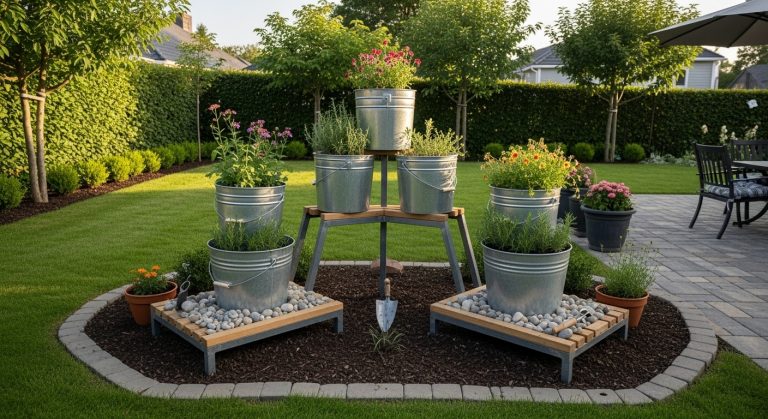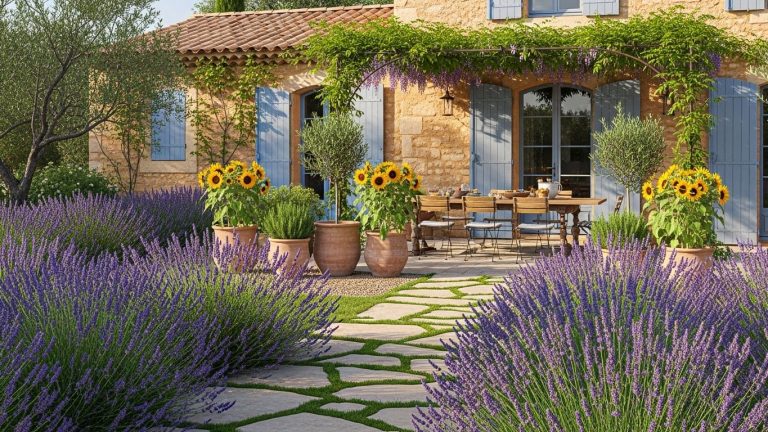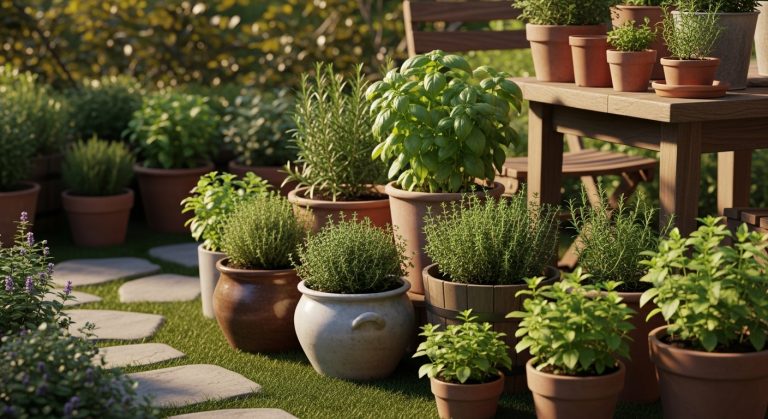15 Daylily Garden Ideas to Transform Your Backyard This Season
Ever walk past a garden and think, “How is this so effortlessly gorgeous?” Sometimes, it’s the simplest switch that turns an ordinary backyard into a serene, colorful retreat. Lately, I’ve been obsessed with daylilies—those vibrant, low-maintenance blooms that make any garden feel alive. They’re not just flowers; they’re versatile design tools. From structured borders to wildflower-style pockets of color, daylilies can work in almost any garden style.
If you’ve ever wanted a garden that’s full of life, low-fuss, and always blooming in a rotation of colors, this list is for you. I’ve rounded up 15 practical, achievable, and visually striking ideas for using daylilies that anyone can implement, whether you have a tiny city plot or a sprawling backyard.
1. Layered Border Beds
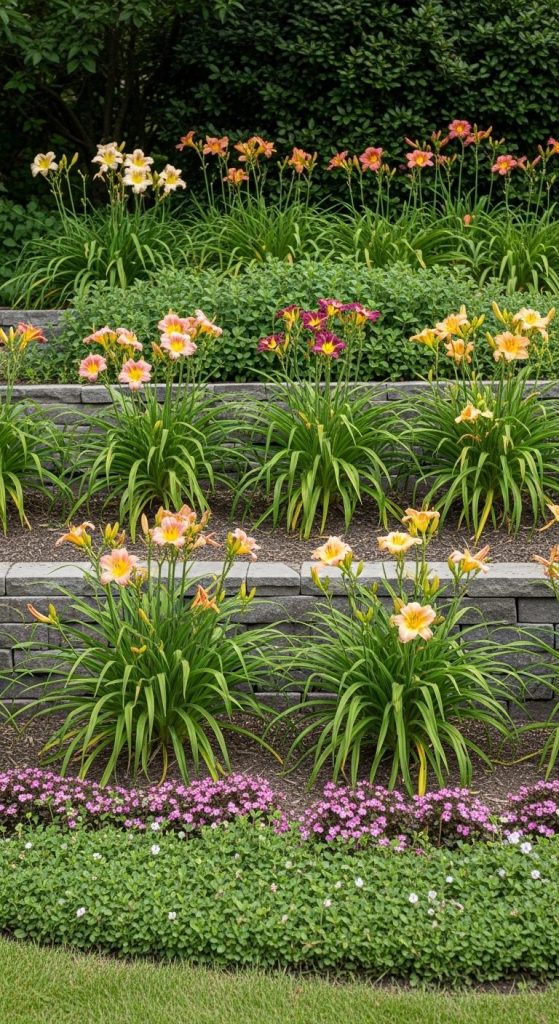
Imagine walking along a garden path where colors rise in gentle waves. Layering daylilies in borders creates depth and visual interest. Plant taller varieties at the back, mid-sized in the middle, and low-growing types in front.
Pros:
- Adds instant depth and dimension
- Bloom rotation keeps the border lively all season
- Simple to maintain once established
Cons:
- Requires careful planning of heights and bloom times
- Can need more initial soil prep
Mini takeaway: Layered borders make a garden feel professionally designed without hiring a landscaper.
2. Mixed Perennial Beds
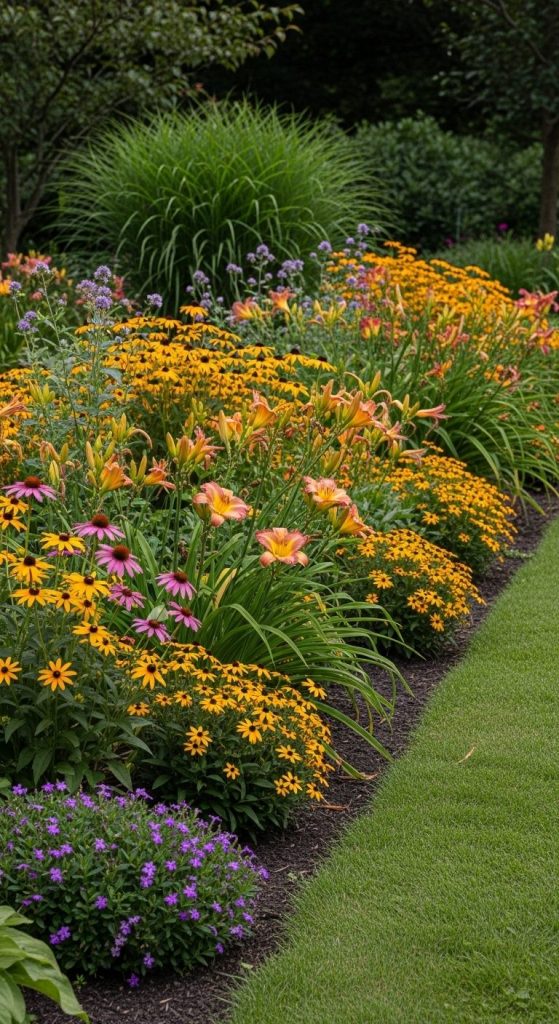
Daylilies pair beautifully with other perennials like coneflowers, black-eyed Susans, or ornamental grasses. The mix creates a dynamic, textured bed that evolves week by week.
Pros:
- Extends the visual interest of your garden
- Encourages pollinators
- Great for naturalistic garden styles
Cons:
- Competition for nutrients if not spaced correctly
- May need pruning to prevent overcrowding
Mini takeaway: Mixing daylilies with other perennials gives a lush, lived-in garden feel.
3. Cottage Garden Style
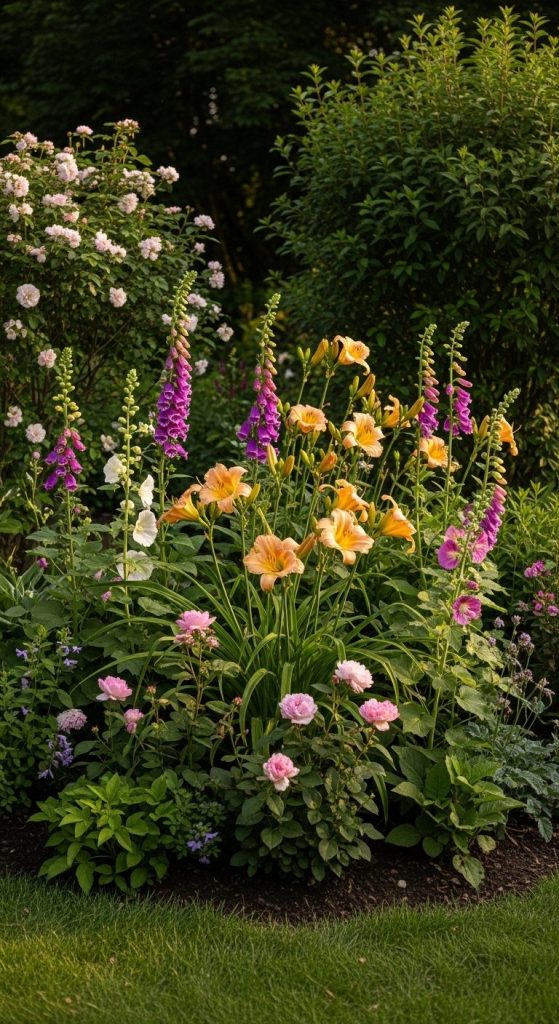
If you love that “charming and cozy” vibe, daylilies are perfect for a cottage garden. Let them intermingle with foxgloves, hollyhocks, and roses for a romantic, slightly wild look.
Pros:
- Low-maintenance yet visually full
- Offers a timeless, romantic feel
- Attracts bees and butterflies
Cons:
- Can look messy if not lightly managed
- Needs careful color coordination
Mini takeaway: Daylilies can anchor a whimsical, storybook-style garden effortlessly.
4. Garden Path Accents
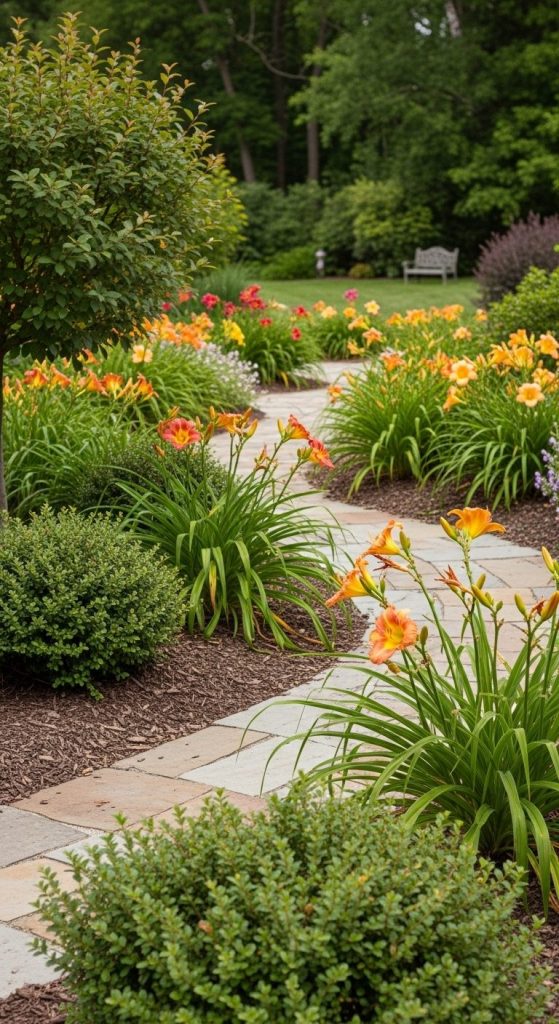
Planting daylilies along walkways or stepping stone paths adds color and guides the eye. Use bright oranges or yellows for contrast against green foliage or neutral stones.
Pros:
- Visually guides visitors through your garden
- Adds seasonal bursts of color
- Minimal effort to plant along edges
Cons:
- Needs regular deadheading for tidiness
- Foot traffic may compact soil
Mini takeaway: Even a simple path can become a highlight with well-placed daylilies.
5. Daylily Hedges
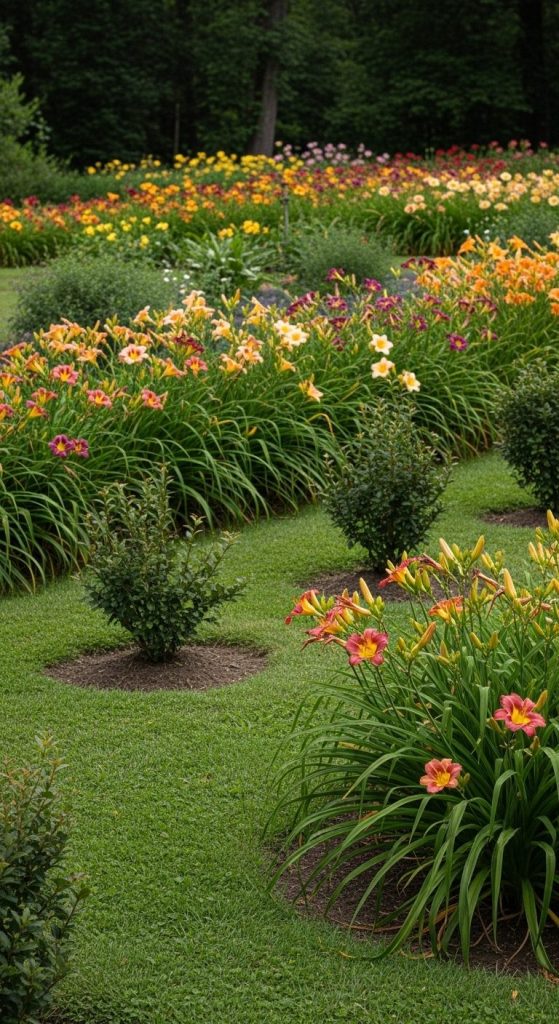
Tall varieties can form informal hedges. Unlike boxwood, these bloom in summer, giving your boundary a dual function: privacy and color.
Pros:
- Softens garden edges
- Blooms while still providing structure
- Natural wildlife habitat
Cons:
- Won’t stay green year-round like shrubs
- May need replanting over time for fullness
Mini takeaway: A blooming hedge gives both style and function in one shot.
6. Raised Beds Display
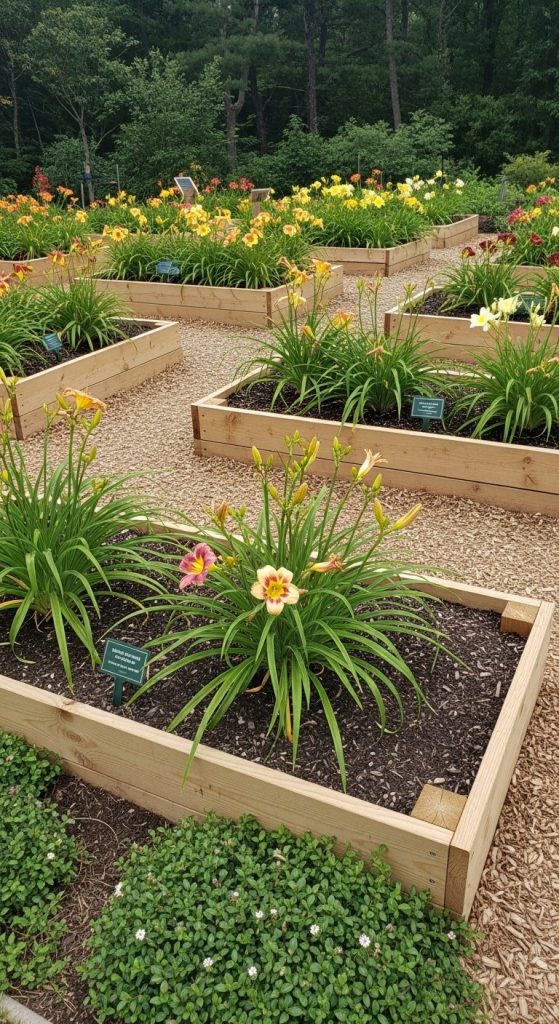
Raised beds bring flowers closer to eye level and make maintenance easier. Grouping daylilies in a raised structure creates a dramatic focal point in any garden.
Pros:
- Easier to weed and water
- Dramatic visual impact
- Improves drainage for healthier plants
Cons:
- Slightly higher initial cost for materials
- Soil may dry faster in summer
Mini takeaway: Raised beds are a gardener’s shortcut to instant wow factor.
7. Containers and Patio Displays
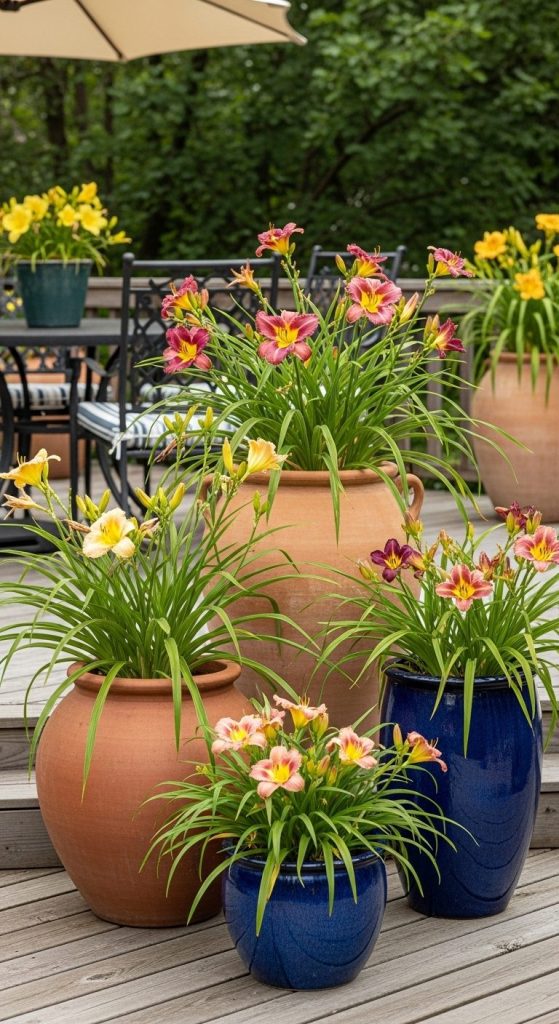
Don’t have a yard? No problem. Daylilies thrive in large pots and containers. Mix several colors in one planter for a mini flower show on patios or decks.
Pros:
- Perfect for small spaces
- Easy to move for sun or shade needs
- Allows experimentation with color combinations
Cons:
- Needs more frequent watering
- Limited bloom volume compared to ground planting
Mini takeaway: Even balcony gardeners can enjoy the charm of daylilies in vibrant containers.
8. Butterfly and Pollinator Gardens

Daylilies naturally attract butterflies and bees. Pair them with lavender, bee balm, and salvia to create a buzzing, lively pollinator-friendly zone.
Pros:
- Supports local wildlife
- Adds movement and sound to the garden
- Encourages a natural ecosystem
Cons:
- Some flowers may get nibbled by insects
- Requires seasonal cleanup
Mini takeaway: Your garden becomes a mini wildlife sanctuary with very little extra effort.
9. Seasonal Color Rotation
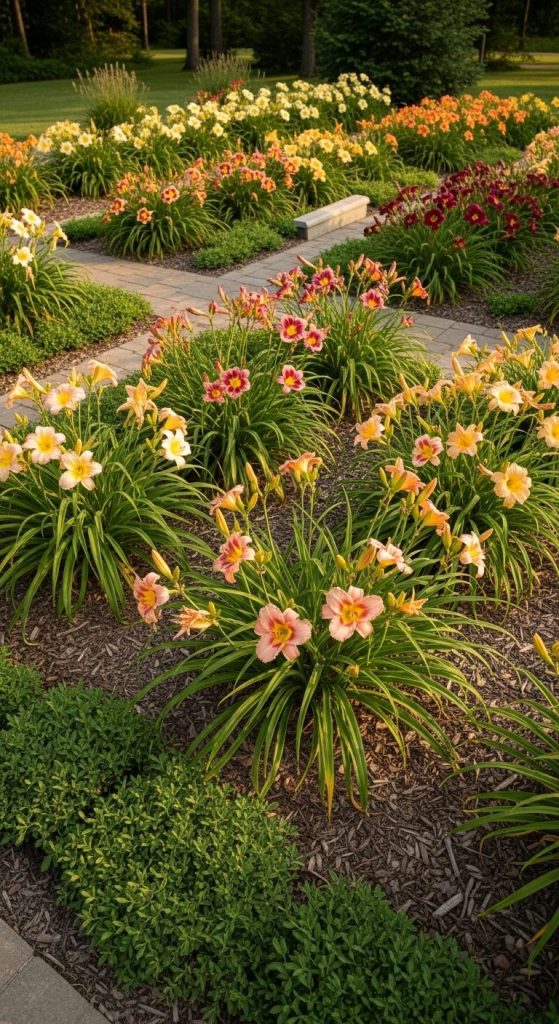
Different daylily varieties bloom at varying times. Plant early, mid, and late-season bloomers to keep your garden colorful from spring to fall.
Pros:
- Continuous visual interest
- Staggers gardening chores
- Offers unique textures as each variety blooms
Cons:
- Requires research to select complementary bloom times
- Some varieties may dominate others
Mini takeaway: Thoughtful timing ensures your garden never looks “empty.”
10. Water Feature Companion

Daylilies love slightly moist soil, making them ideal companions for ponds, streams, or fountains. Their vibrant blooms reflect beautifully in water.
Pros:
- Enhances water garden aesthetics
- Can prevent soil erosion near water edges
- Attracts wildlife
Cons:
- Overcrowding can block water views
- Needs careful soil moisture management
Mini takeaway: Strategic placement makes daylilies double as artful framing for water features.
11. Rock Garden Integration
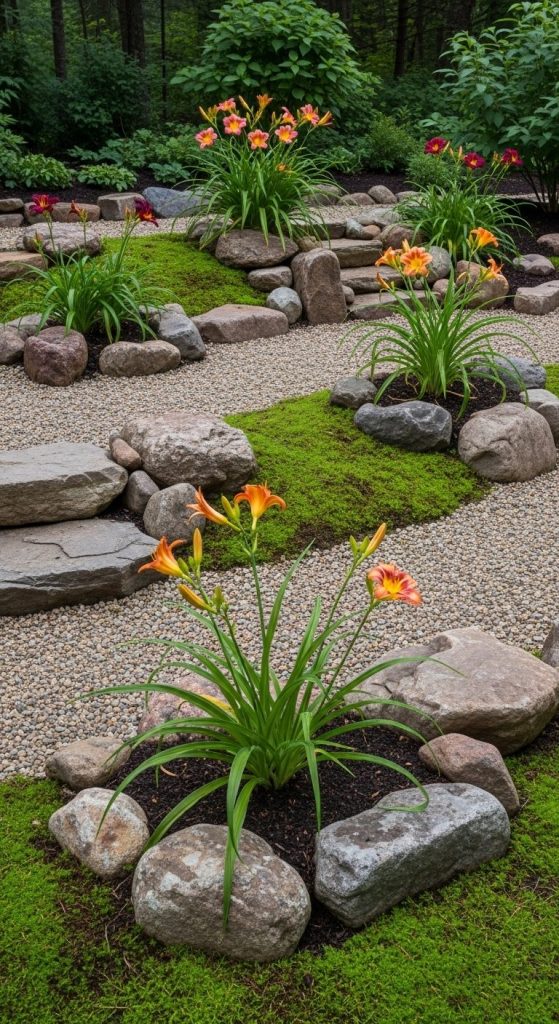
Hardscaping like rocks or boulders pairs surprisingly well with daylilies. Their bold flowers contrast against rugged textures, softening harsh edges.
Pros:
- Creates a low-maintenance, durable garden
- Offers year-round structure
- Perfect for sloped or uneven areas
Cons:
- Needs soil pockets for planting
- Can dry out quickly in hot sun
Mini takeaway: Rocks plus daylilies make a dramatic statement with minimal upkeep.
12. Window Box Highlights
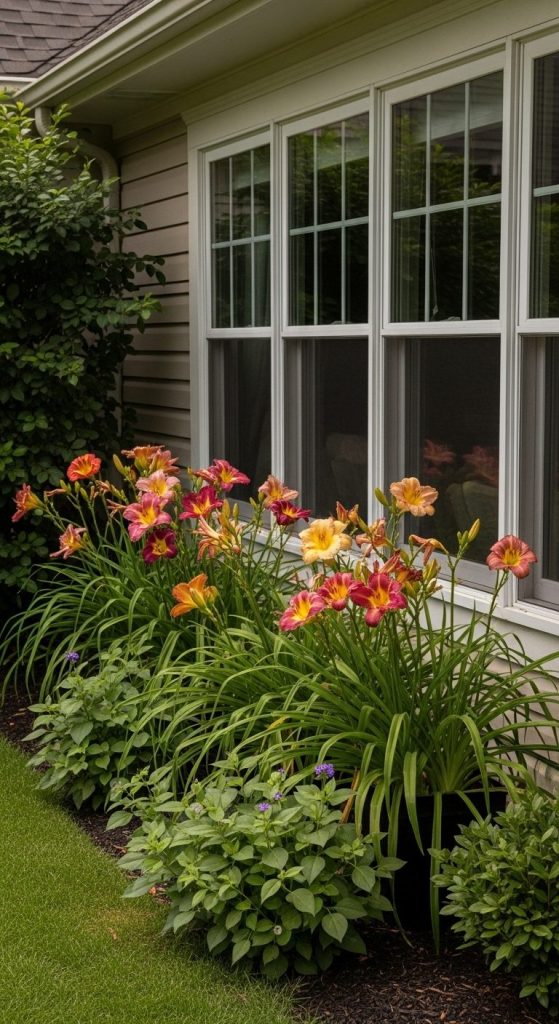
Daylilies can thrive in deep window boxes. Planting them outside kitchen or living room windows adds color to your view and smells sweetly in the summer.
Pros:
- Enhances home exterior
- Low-care way to enjoy blooms up close
- Great for small gardens or rentals
Cons:
- Soil needs replenishing each season
- Limited root space restricts growth
Mini takeaway: Even small homes can have a vibrant flower display with creative placement.
13. Bold Monochromatic Beds
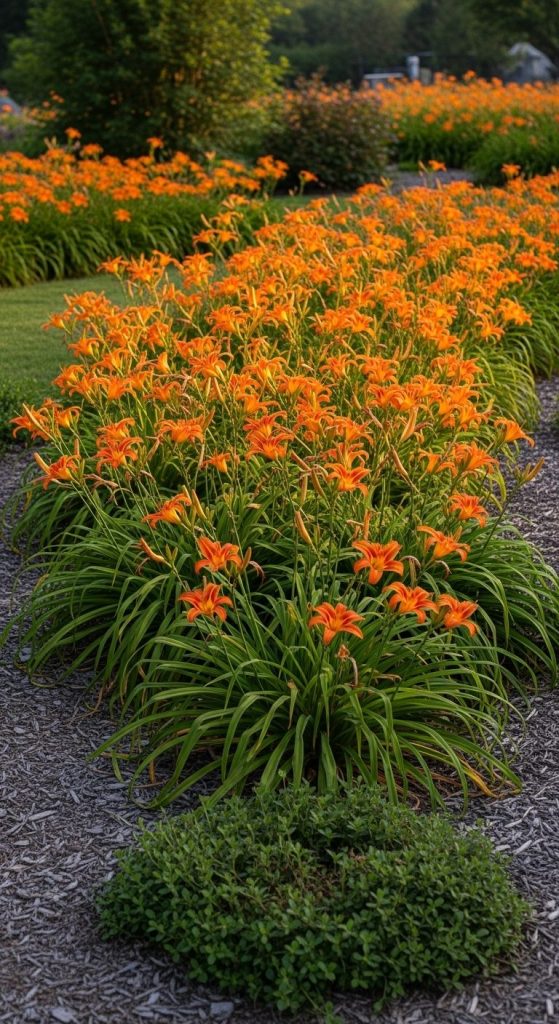
Sometimes, sticking to one color can have a massive visual impact. Plant a bed entirely of bright orange or deep red daylilies for a show-stopping effect.
Pros:
- Strong, dramatic impact
- Easy to maintain cohesive look
- Highlights unique textures of leaves and flowers
Cons:
- Less varied visual interest
- May feel intense in small spaces
Mini takeaway: One-color gardens can be surprisingly elegant when done intentionally.
14. Pollinator Strip Borders
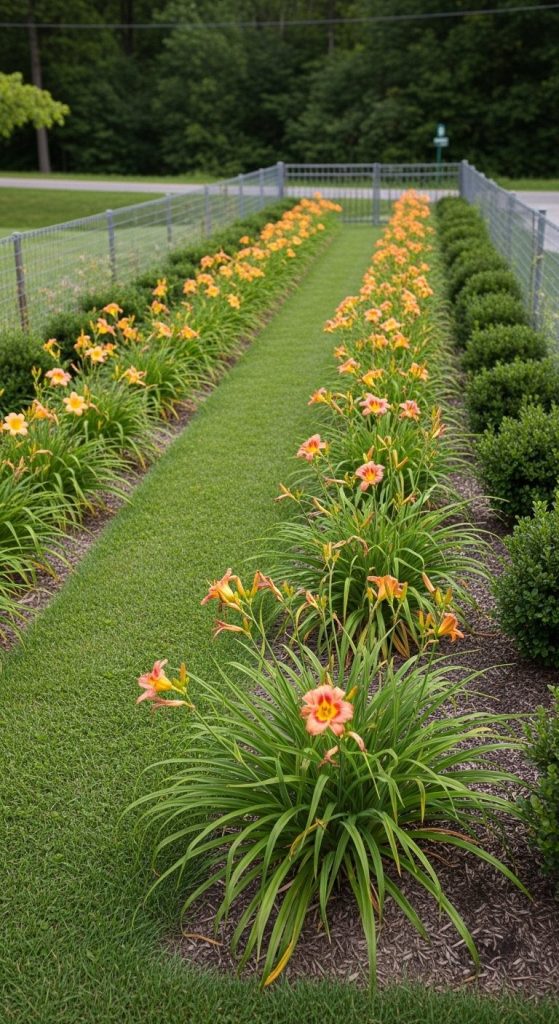
Plant long, narrow strips of daylilies along fences or driveway edges to create functional yet pretty corridors. The flowers guide pollinators while softening rigid boundaries.
Pros:
- Creates continuity in the garden
- Supports wildlife movement
- Adds seasonal blooms without large beds
Cons:
- Narrow strips may require extra care to prevent soil compaction
- Might need edging to keep tidy
Mini takeaway: Even small linear spaces can serve as mini sanctuaries for bees and butterflies.
15. Sunset Color Themes
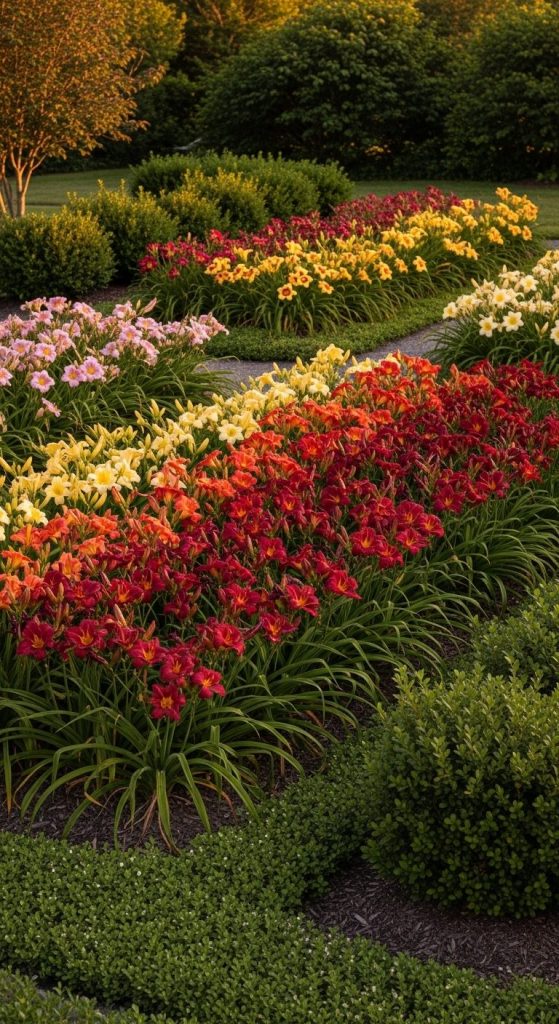
Daylilies come in soft pastels, vibrant oranges, and deep reds. Arrange varieties to mimic sunset gradients across your garden for a natural, serene palette.
Pros:
- Stunning visual storytelling through color
- Encourages thoughtful planning and layout
- Inspires relaxing evening views
Cons:
- Needs careful variety selection
- Might require extra space for gradient effect
Mini takeaway: A sunset-inspired garden turns ordinary flower beds into tranquil escapes.
Conclusion
Daylilies are more than just flowers; they’re versatile tools for transforming gardens of all sizes and styles. Whether you prefer cottage charm, bold monochrome beds, or pollinator-friendly layouts, these 15 ideas prove that vibrant blooms and low-maintenance gardening can coexist beautifully. Personally, I love the layered border approach—it feels both structured and alive, like the garden is quietly humming to itself.
The beauty of daylilies is that they’re forgiving, resilient, and endlessly adaptable. Pick one or combine a few approaches, and suddenly your backyard becomes a space you actually want to linger in. Try your favorite one first, see what clicks with your space and lifestyle, and watch your garden evolve into something truly special.

William Martin is a passionate bowler who spends most of his weekends playing the sport. With years of intense experience under his belt, William decided to share his knowledge by creating BOWLING OCEAN. Join me on this journey to explore the world of bowling and discover the tips and tricks to becoming a pro.




